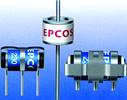
Every year, electrical and electronic equipment suffers billions of dollars worth of damage as a result of inadequate protection. The greatest dangers are excessive voltage, current and temperature.
Their far reaching consequences range from annoying glitches in entertainment electronics through serious economic losses caused by the failure of production plant right up to breakdowns that can threaten human life. If the useful life of equipment is reduced by extended operation at or above the upper temperature limits, the indirect damage resulting is as hard to quantify.
Electronics has moved into our everyday lives and increasingly determines products' performance, efficiency and competitiveness. However, this technology is only a blessing as long as electronic equipment operates safely and reliably. Epcos is one company that offers the right protective components for every application. In this short series, Dataweek will publish (in parts) an article that explains the various components available and the advantages of each in its respective correct application.
Gas-filled surge arresters
Epcos offers a wide range of arresters from light-duty to heavy-duty types (70 V to 5 kV/0,5 kA to 60 kA), has technical approval from virtually all power grid operators and is the only global supplier.

As Thomas Leuschner, head of surge arrester product marketing at Epcos, explains, "Surge arresters are mainly used to protect subscriber lines, telecom and data equipment as well as AC power lines. Their great advantage is their large reserve of surge current capability. So users do not need to conduct detailed studies of maximum permissible current amplitudes."
Other positive features are their extremely low self-capacitance of less than 2 pF and low leakage current of less than 10 nA. These figures also apply at high temperatures, so that gas-filled surge arrestors have virtually no reaction on the system and can be used reliably in data lines operating at the highest transmission rates. Used in new transmission technologies such as DSL, which require an even higher level of protection for the communication network, these arresters offer major advantages: high surge-current discharge capability (2,5 to 40 kA), low impulse sparkover voltage (less than 450 V) and extremely low self-capacitance (about 1 pF) with simultaneously high insulation resistance (more than 1 GW).
A combination of gas-filled surge arresters and varistors - in some cases complemented by a short-circuit mechanism - provides optimum protection for telecom equipment in central offices and subscriber lines. Combining the high current capability of a surge arrester with the fast response of varistors, this hybrid component reliably limits voltage transients to acceptable values below 350 V (at a voltage rise dv/dt of 1 kV/µs) and protects against surge currents up to 20 kA (8/20 µs wave) or 1000 A (10/1000 µs wave).
The hybrid also assures reliable protection against voltage surges on power lines. The varistors are then connected in series. They limit the current flowing through the surge arresters, which would otherwise reach unacceptably high values due to the low internal resistance of the power line and the negative voltage/current characteristic of the arrester.
"This combination offers lower costs and takes up less space than discrete solutions," Leuschner explains. "Our two overvoltage protection components thus complement each other ideally."
In gas-filled surge arresters too, the general trend is toward miniaturisation and automatic placement. That is why Epcos already offers several arrester types as surface mount devices (SMDs).
In Part II of this series to follow, we will take a look at NTC thermistors.
| Tel: | +27 11 458 9000 |
| Email: | [email protected] |
| www: | www.electrocomp.co.za |
| Articles: | More information and articles about Electrocomp |

© Technews Publishing (Pty) Ltd | All Rights Reserved